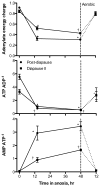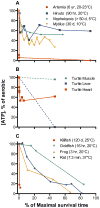Long-Term survival of anoxia despite rapid ATP decline in embryos of the annual killifish Austrofundulus limnaeus
- PMID: 22927170
- PMCID: PMC3463713
- DOI: 10.1002/jez.1744
Long-Term survival of anoxia despite rapid ATP decline in embryos of the annual killifish Austrofundulus limnaeus
Abstract
Embryos of the annual killifish Austrofundulus limnaeus can survive for months in the complete absence of oxygen. Survival of anoxia is associated with entry into a state of metabolic dormancy known as diapause. However, extreme tolerance of anoxia is retained for several days of post-diapause development. Rates of heat dissipation in diapause II and 4 days post-diapause II embryos were measured under aerobic conditions and during the transition into anoxia. Phosphorylated adenylate compounds were quantified in embryos during entry into anoxia and after 12 hr of aerobic recovery. Rates of heat dissipation were not affected by exposure to anoxia in diapause II embryos, while post-diapause II embryos experienced a profound decrease in heat dissipation. ATP decreased substantially in both developmental stages upon exposure to anoxia, and all indicators of cellular energetic status indicated energetic stress, at least based on the mammalian paradigm. The rate of decline in ATP is the most acute reported for any vertebrate. The mechanisms responsible for cellular survival despite a clear dysregulation between energy production and energy consumption remain to be identified. Necrotic and apoptotic cell death in response to hypoxia contribute to poor survival during many diseases and pathological conditions in mammals. Understanding the mechanisms that are in place to prevent maladaptive cell death in embryos of A. limnaeus may greatly improve treatment strategies in diseases that involve hypoxia and reperfusion injuries.
2012 Wiley Periodicals, Inc
Conflict of interest statement
The authors declare no conflicts of interest associated with this work.
Figures





Similar articles
-
Extreme anoxia tolerance in embryos of the annual killifish Austrofundulus limnaeus: insights from a metabolomics analysis.J Exp Biol. 2007 Jul;210(Pt 13):2253-66. doi: 10.1242/jeb.005116. J Exp Biol. 2007. PMID: 17575031
-
Cell cycle regulation during development and dormancy in embryos of the annual killifish Austrofundulus limnaeus.Cell Cycle. 2012 May 1;11(9):1697-704. doi: 10.4161/cc.19881. Epub 2012 May 1. Cell Cycle. 2012. PMID: 22531486 Free PMC article. Review.
-
Hypoxia and Anoxia Tolerance in the Annual Killifish Austrofundulus limnaeus.Integr Comp Biol. 2016 Oct;56(4):500-9. doi: 10.1093/icb/icw092. Epub 2016 Aug 9. Integr Comp Biol. 2016. PMID: 27507238
-
Small noncoding RNA expression during extreme anoxia tolerance of annual killifish (Austrofundulus limnaeus) embryos.Physiol Genomics. 2017 Sep 1;49(9):505-518. doi: 10.1152/physiolgenomics.00016.2017. Epub 2017 Aug 11. Physiol Genomics. 2017. PMID: 28802262
-
Dispersion/reaggregation in early development of annual killifishes: Phylogenetic distribution and evolutionary significance of a unique feature.Dev Biol. 2018 Oct 1;442(1):69-79. doi: 10.1016/j.ydbio.2018.07.015. Epub 2018 Jul 21. Dev Biol. 2018. PMID: 30040922 Review.
Cited by
-
MitosRNAs and extreme anoxia tolerance in embryos of the annual killifish Austrofundulus limnaeus.Sci Rep. 2019 Dec 24;9(1):19812. doi: 10.1038/s41598-019-56231-2. Sci Rep. 2019. PMID: 31874982 Free PMC article.
-
Genome of the Rio Pearlfish (Nematolebias whitei), a bi-annual killifish model for Eco-Evo-Devo in extreme environments.G3 (Bethesda). 2022 Apr 4;12(4):jkac045. doi: 10.1093/g3journal/jkac045. G3 (Bethesda). 2022. PMID: 35188191 Free PMC article.
-
Mitochondria from anoxia-tolerant animals reveal common strategies to survive without oxygen.J Comp Physiol B. 2014 Apr;184(3):285-302. doi: 10.1007/s00360-014-0806-3. Epub 2014 Feb 7. J Comp Physiol B. 2014. PMID: 24504264 Review.
-
The genome of Austrofundulus limnaeus offers insights into extreme vertebrate stress tolerance and embryonic development.BMC Genomics. 2018 Feb 20;19(1):155. doi: 10.1186/s12864-018-4539-7. BMC Genomics. 2018. PMID: 29463212 Free PMC article.
-
Developmentally arrested Austrofundulus limnaeus embryos have changes in post-translational modifications of histone H3.J Exp Biol. 2016 Feb;219(Pt 4):544-52. doi: 10.1242/jeb.131862. Epub 2015 Dec 18. J Exp Biol. 2016. PMID: 26685169 Free PMC article.
References
-
- Adolph EF. Regulations during survival without oxygen in infant mammals. Resp Physiol. 1969;7:356–368. - PubMed
-
- Anchordoguy TJ, Hand SC. Acute blockage of the ubiquitin-mediated proteolytic pathway during invertebrate quiescence. Am J Physiol Regul Integr Comp Physiol. 1994;267:R895–R900. - PubMed
-
- Chennault T, Podrabsky JE. Aerobic and anaerobic capacities differ in embryos of the annual killifish Austrofundulus limnaeus that develop on alternate developmental trajectories. J Exp Zool A. 2010;313A:587–596. - PubMed
-
- Davies RW, Yang T, Wrona FJ. Inter- and intra-specific differences in the effects of anoxia on Erpobdellid leeches using static and flow-through systems. Ecology. 1987;10:149–153.
-
- Duerr JM, Podrabsky JE. Mitochondrial physiology of diapausing and developing embryos of the annual killifish Austrofundulus limnaeus: implications for extreme anoxia tolerance. J Comp Physiol B. 2010;180:991–1003. - PubMed
Publication types
MeSH terms
Substances
Grants and funding
LinkOut - more resources
Full Text Sources

